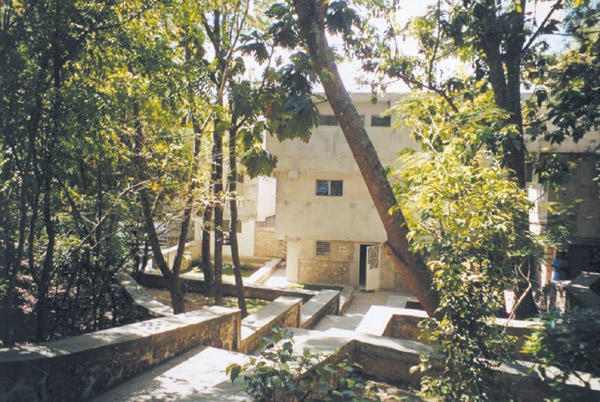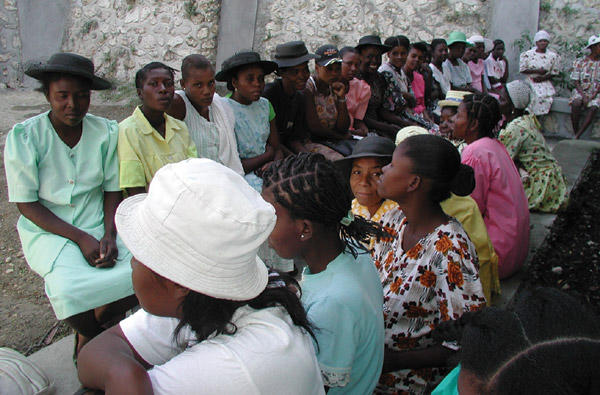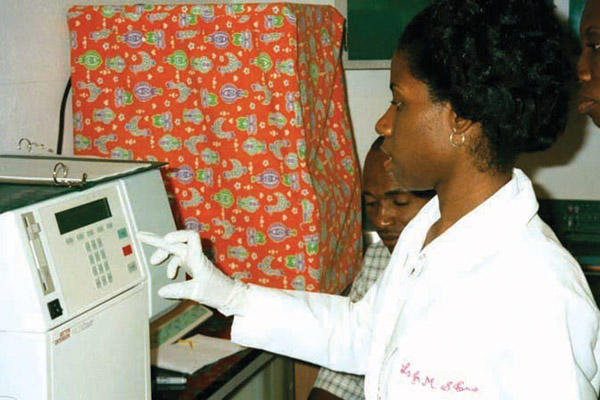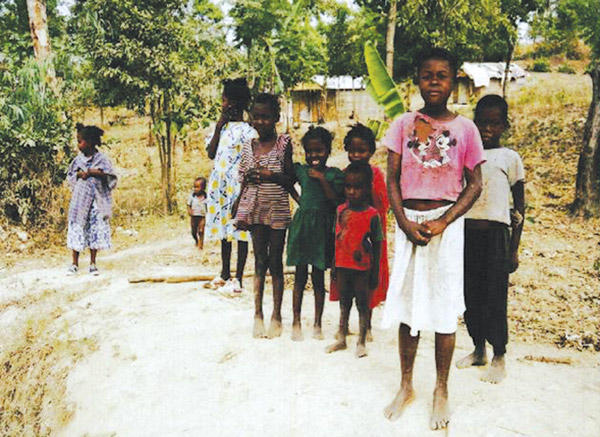Abstract
HIV/AIDS, tuberculosis and social inequalities
More than 50 years after the introduction of chemotherapy for the treatment of tuberculosis (TB), the disease is far from being under control. Among curable infectious diseases, TB remains the number-one killer—each year, 2 million people still die of the disease and 8.4 million more fall ill (World Health Organization (WHO), 2002a). And future projections are grim. Fewer than half of all TB cases are diagnosed, and of those that are, fewer than 30% have access to the care recommended by the WHO (WHO, 2002a). The increase in TB worldwide is due, in part, to the expansion of the HIV/AIDS pandemic (WHO, 2001): at least one-third of people with HIV die of TB (WHO, 2002a). HIV/AIDS now causes more than 3 million deaths per year (UNAIDS, 2002). More than 90% of HIV/AIDS deaths and new infections occur in poor countries where less than 5% of those who need antiretroviral treatment have access to these therapies (WHO, 2002b). If we consider that, on average, 10% of people with HIV need antiretroviral treatment, the 5% figure comes down to less than 1% in subsaharan Africa, the region most affected by the pandemic.
The social contexts in which our patients became infected are an integral part of their stories
Large-scale social forces, such as racism, sexism, political violence, poverty and other social inequalities, are rooted in historical and economic processes and sculpt the distribution and outcome of HIV/AIDS and TB. We refer to these social forces as 'structural violence' (Castro & Farmer, 2002, 2003a,b; Farmer, 2003), which predisposes the human body to pathogenic vulnerability by shaping the risk of infection and subsequent disease reactivation. After infection, structural violence also determines who has access to diagnostics and effective therapy. Drugs that could stop or slow down these epidemics, such as first- and second-line antituberculosis medications and antiretrovirals, are not available in the places where they are needed most, where these diseases take their highest toll. And so the uneven distribution of medical and technological advances contributes to increasing the 'outcome gap', shaping the incidence and prevalence of infectious disease at the individual and social levels.
Often, public health experts recommending policy for poor countries believe that the high cost of treatment, the lack of infrastructure and the lack of patients' adherence to treatment render disease control and treatment impossible. Our own experience in providing health and social services in rural Haiti suggests that this is not necessarily so (Farmer et al., 2001; Farmer & Castro 2002). Haiti is the most impoverished country in Latin America and the country most affected by TB and HIV/AIDS in the region, with a prevalence of the latter in adults of up to 6% (UNAIDS, 2002). To illustrate how inextricably linked structural violence is to infectious diseases, and how social forces such as poverty become embodied, we explore the histories of three patients in the Partners In Health hospital in rural Haiti (Clinique Bon Sauveur; Figs 1,2,3). Two of these patients are affected by HIV/AIDS and one is ill with multidrug-resistant TB (MDR-TB)—that is, TB resistant to at least isoniazid and rifampin. The social contexts in which our patients became infected are an integral part of their stories. We outline the measures we took to provide these patients with treatment and, where possible, to redress some of the social inequalities that caused them to fall prey to disease.
Figure 1.

Clinique Bon Sauveur in Cange, rural Haiti. © 2000 Partners in Health.
Figure 2.

Women waiting outside the women's clinic of Clinique Bon Sauveur in rural Haiti. © (2002) Arachu Castro/Partners in Health.
Figure 3.

FACS (flow cytometer) machine at the Clinique Bon Sauveur, to perform CD4 counts for rural HIV patients. © 2002 Partners in Health.
Because the 'texture' of dire affliction is felt better from the gritty details of biography, and as any example begs the question of its relevance, we argue that the stories of our three patients are anything but anecdotal. In the eyes of the epidemiologist, as well as of the political analyst, they suffered in exemplary fashion. Millions of people living in similar circumstances can expect to meet similar fates. What these victims—past and present—share are not personal or psychological attributes. They do not share culture, language or a particular race. What they do share is the experience of occupying the bottom rung of the social ladder in inegalitarian societies.
Adeline, 36 years old, was born in the village of Kay Epin, in Haiti's Central Plateau. Of Adeline's eight siblings, five are still alive. Her parents are peasant farmers, although her father supplements his income by helping to run a local school. Adeline grew up in the village, leaving rarely, except to accompany her mother to the closest market. When she was 18, she left for the capital, Port-au-Prince, to continue her primary education. Adeline did not remain in school for long—her grades were poor and the cost of tuition high—and she ended up in a part-time vocational school where she learned to sew and embroider. She lived with a sister in Cité Soleil, a slum on the northern edge of the city. Finding enough to eat was a constant struggle. Not long after her arrival in the city, Adeline married Joel, a young man from the Central Plateau, and soon gave birth to a son. Joel fell ill shortly after the birth, and died only a year later. Adeline does not know what killed him, but now assumes it was HIV.
When Adeline's son was about two years old, she met Ronald, the father of her second child. He is still around, she notes, “but I'm no longer with him. He doesn't help me at all with feeding these children. I never see him.” During her early twenties, Adeline had an episode of pneumonia, which brought her home and to our clinic in rural Haiti. She was also diagnosed with herpes zoster, which led to the diagnosis of her HIV infection.
For almost ten years Adeline's therapy was limited to the treatment of her opportunistic infections. By early 1999, Adeline's chronic enteropathy no longer responded to antimotility agents. By October she weighed 36 kg (79 lb) and could no longer get out of bed. Her father, desperate, asked us for help to buy a coffin for her.
But our response was much more ambitious: instead of a coffin, we gave Adeline
Structural violence, by diminishing the margin of individual agency to make choices in life, opens the road to the transmission of HIV to poor women
a cocktail of three anti-HIV drugs. In November 1999, Adeline began therapy with zidovudine, 3TC and indinavir, at no cost to her. Her diarrhoea disappeared within two weeks; she gained 12 kg (26 lb) in the first five weeks of treatment (Farmer et al., 2001). Adeline commented: “What can I say? The medicines are eloquent enough. What they have done for me is amazing. Everyone was shocked when I went home for Christmas. I was so sick before I started treatment. I was skinny, and the medicines made me big again. I was so weak I could not walk, and now look at me.” Adeline is currently one of our community health workers, receives daily highly active antiretroviral therapy (HAART) and takes care of her children, who are going to school. She added, “If the drugs cost a lot, there must be a reason. Science made them, so science will have to find a way to get them to poor people, since we're the ones who have AIDS.” Having access to comprehensive AIDS care (Castro et al., 2003) has saved her life, and securing a job and school fees for her children has allowed her to avoid going back to the miserable conditions in which she lived before.
Enna, at age 26, has already given birth to six children. Born to an impoverished family in Savanette, she was sent to Port-au-Prince as a restavèk—a child servant—at ten years of age: “I used to mop the floor and cook. I also used to baby-sit.” Enna was not paid but “they gave me food to eat”. At age 14, she was raped: “A man who was a friend of the family where I was staying raped me. He waited until no one was home, then he jumped on me. I was just a child; I did not know what was happening. This happened four times, and then I was pregnant. The family [in Port-au-Prince] sent me away.” Enna returned to Savanette, where she almost died in childbirth.
She later sold produce in regional markets and in Port-au-Prince. At 18 years of age, while sleeping in a communal market depot, three men raped her. “I didn't see them, so what could I tell the police? Besides, I was afraid of the police.” Enna regards “my entire life as a disaster. I had three children from two different men, but neither of them would help me [financially].” In 1997, sapped by recurrent fevers and chronic diarrhoea, she was diagnosed with TB and HIV. Treated for TB, she gained weight but later developed oropharyngeal candidiasis and mental impairment. She lost weight and had intermittent diarrhoea. Enna received zidovudine during her sixth pregnancy, but the newborn baby died of severe jaundice. When her weight dropped to 49 kg (108 lb), she was started on a regimen of zidovudine, 3TC and efavirenz. She gained 4 kg (9 lb) in the first six months of therapy and now has no symptoms.
Adeline's and Enna's stories are not that different from the stories of hundreds of poor women with HIV/AIDS in rural Haiti. Table 1 illustrates the main social conditions that increased the risk of HIV among the first 25 women diagnosed with the infection at our clinic. These young women fled to Port-au-Prince in an attempt to escape from the harshest poverty. Once in the city, most of them worked as domestic servants; none managed to find the financial security that had proved so elusive in the countryside. Many of them were forthright about the non-voluntary aspect of their sexual activity, as they knew that poverty had forced them into unfavourable unions that could secure them a steady source of income, especially if their partners were soldiers or truck drivers rather than peasant farmers. Structural violence, by diminishing the margin of individual agency to make choices in life, opens the door to the transmission of HIV to poor women.
Table 1. Case–control study of AIDS in rural Haitian women, Central Plateau, from the late 1980s.
| Patient characteristics | Patients with AIDS (n = 25) | Control group (n = 25) |
|---|---|---|
| Average number of sexual partners | 2.7 | 2.4 |
| Sexual partner of a truck driver | 12 | 2 |
| Sexual partner of a soldier | 9 | 0 |
| Sexual partner of a peasant only | 0 | 23 |
| Ever lived in Port-au-Prince | 20 | 4 |
| Ever worked as a servant | 18 | 1 |
| Average years of formal schooling | 4.5 | 4 |
| Ever received a blood transfusion | 0 | 2 |
| Ever used illicit drugs | 0 | 0 |
| Received more than ten intramuscular injections | 17 | 19 |
Source: Clinique Bon Sauveur, Zanmi Lasante, Haiti (taken from Farmer, 1999).
The Josephs are a large family crowded into a small house in a poor neighbourhood in Port-au-Prince. Madame Joseph sells wares in the streets of the city; her husband is an irregularly employed construction worker. Although they live in poverty by any standard, theirs is a household in which it might be expected that all eight children would attend school; one or two of them might even be expected to find jobs.
One of their most talented children is Jean, who was a healthy 21-year-old student in 1997. The way Jean recalls it, his family's problems began when he started to cough. At first he sought to treat his persistent hacking with herbal teas. But when his cough worsened, he began to think he might have something other than a banal cold. In the second month of his illness, now with back pain and a fever, Jean took himself to a TB hospital in Port-au-Prince that is run by a non-governmental organization (NGO). “It's not that I thought I had tuberculosis,” he recalled. “Not at all. It's rather that I knew they could take a chest X-ray.” But Jean did indeed have TB, and he was started that day on a four-drug regimen that included not only rifampin, but also streptomycin, a drug that is injected intramuscularly. “I took all my medications,” he recalled anxiously, “but I kept coughing.”
Towards the end of the year, Jean's fears were heightened by an episode of haemoptysis. Coughing up bright red blood terrified the young man, as it did his entire family. “I knew I was getting worse, so I went to a pulmonologist.” The specialist wondered why streptomycin had been included in the initial regimen, as most rifampin-containing regimens do not include the injectable drug. He referred Jean to the national TB sanatorium in January 1998, where he was found to be floridly smear-positive—which means that there were many TB bacilli in his sputum—and was admitted for further therapy.
Jean was an inpatient for almost three months, during which time he had therapy, under direct observation, with the same drugs he had received previously. He remained smear-positive throughout his time there. “I was discouraged, I wanted to stop [taking the medications]. I was sure these medicines wouldn't do anything for me, since I had taken them for over a year and been positive the whole time. I stopped taking them and went to a herbalist (doktè fey) for a few weeks.” Jean was treated with various concoctions containing the bark and leaves of trees believed to cure “tuberculosis and other lung disease”. But his symptoms persisted, and when he again began to cough up blood, he returned to the sanatorium. Again, he was prescribed the same first-line drugs, including rifampin and isoniazid. During that time, he was placed in an open ward with other patients, many of them with drug-resistant diseases. “None of them were getting better,” Jean recounted. “They started talking about other medicines that were better, but they said that the government either didn't have the medicines or wasn't going to distribute them.”
The names of these drugs are kanamycin, cycloserine, ethionamide and ciprofloxacin. They are far more expensive, more toxic, and less effective than rifampin and isoniazid. There is little reason, then, to take them—unless you have the misfortune to have MDR-TB. In these cases, such 'second-line' drugs often hold the only real hope of a cure. Once Jean's parents had the names of these drugs, and a prescription from one of the pulmonologists, they started selling off their assets—furniture, a piece of land—to buy the medication. “I started taking [second-line] medicines inside the sanatorium, and I was soon [smear-]negative. In July, I went home,” Jean recalled. “But after five months of treatment, my parents couldn't buy any more medicines, and so I had to stop. I became positive again.”
Cost-effectiveness arguments have, so far, mostly contributed to a strengthening of structural violence and an amplification of the outcome gap
Jean soon had fevers every night and suffered from drenching sweats. He coughed incessantly, and lived in fear of haemoptysis—he had learned during his sanatorium stay that this symptom could rapidly prove fatal. But the situation was to become even worse. “Even though I had stopped coughing blood, my sister Maryse began coughing in about October, and then she started coughing up blood.” One after another, the Joseph children became ill: after Maryse, the oldest, came Myrlene, who had suffered for years with sickle-cell anaemia. Then came Kenol, the youngest. Finally, Shella started coughing. And one by one the Joseph siblings began treatment with first-line drugs. None of them improved; “I felt terrible,” Jean recalled wistfully. “I was getting sicker, but I mostly felt guilty. I just knew they had drug-resistant TB, and that's why they weren't getting better. I knew it was my fault.”
Because the Joseph children did not respond to the first-line drugs, the nurse who was administering their streptomycin injections referred them back to the NGO clinic that had originally diagnosed Jean with TB. “She knew we were failing therapy,” recalled Jean, “and she knew it was MDR-TB. But she said the government could not buy the drugs for patients with MDR-TB, it could only buy first-line drugs. So she referred us to [the NGO].” There, Jean was asked to submit a sputum sample for culture and drug-susceptibility testing. “I never got the results. I kept going back every couple of weeks, and they kept telling me to come back again in a couple of weeks.”
Jean worsened. Recurrent haemoptysis and coughing made him sleepless and on edge. He woke up before dawn on those mornings when he'd been lucky enough to sleep. He became wasted, gaunt. His sisters knew that Jean was deeply depressed. “He blamed himself for making us all sick,” said Myrlene. “We tried to reason with him, but he didn't listen. He still blames himself.” But Jean did not give up. “I had heard that there was one place in the country where we could be treated, and couldn't believe it. It seemed even more strange that it would be out in the middle of nowhere when the big hospitals in Port-au-Prince didn't have the medicines for anyone but people who could pay for them. So I came to see for myself.”
In October 1999, Jean left for central Haiti in a crowded truck. He was coughing and short of breath, drawing the attention of the people among whom he was sandwiched. Once at our clinic, he did not speak to anyone involved in treating MDR-TB: “I just spent the morning looking around,” he later recounted. He evidently liked what he saw, because in November all of the Joseph siblings came to the Clinique Bon Sauveur and, following the requisite laboratory work, began therapy for MDR-TB, at no cost to them. All became smear-negative within two months. Today, the five siblings are cured and back at work.
The stories of Adeline, Enna and Jean reflect the situation of the Haitian poor, who constitute most of Haiti's population. Our patients learned early in their lives that it was unlikely that they would ever attend school or have access to electricity or safe drinking water. Furthermore, most Haitians have little access to medical care, making them more vulnerable to contracting, and then exposing their loved ones, to disease. In fact, with AIDS and TB being the leading causes of death in their age group, Adeline, Enna and Jean fared better than many young Haitians (Fig. 4).
Figure 4.

Children in rural Haiti. © (2001) Arachu Castro/Partners in Health.
Infectious diseases are increasingly concentrated among the poor, who live under the tremendous weight of structural violence, and whose social and economic rights are constantly violated. How different would the outcome of Adeline, Enna and Jean's stories have been had TB and HIV/AIDS been deemed to be too expensive to treat in poor settings? What would have happened to them if they had been declared too poor to treat and consequently been denied access to the fruits of research? What happens when scientists no longer invest their time and resources in discovering new drugs and diagnostic tests for those diseases that predominantly affect the poor?
HIV/AIDS and tuberculosis are transnational epidemics that require transnational efforts. The scientific tools for the effective treatment of these diseases, including MDR-TB, are available. Cost-effectiveness arguments have, so far, contributed mostly to a strengthening of structural violence and an amplification of the outcome gap. We argue that public health, medicine and the biological sciences can develop improved tools and make them available where they are most needed. Health policy and the financing of public health should follow the epidemiology of disease, concentrate on equity plans and invest heavily in efforts to redress the social and economic forces that have led the poor to be so at risk of infectious diseases in the first place.


References
- Castro A. & Farmer P. (2002) Anthropologie de la violence: la culpabilisation des victims. Notre Librairie: Rev. Litt. Sud, 148, 102–108. [Google Scholar]
- Castro A. & Farmer P. (2003a) Violence structurelle, mondialisation et tuberculose multirésistante. Anthropol. Soc. (in the press). [Google Scholar]
- Castro A. & Farmer P. (2003b) El sida y la violencia estructural: la culpabilización de la víctima. Cuadernos Antropol. Soc. (in the press). [Google Scholar]
- Castro A. et al. (2003) Scaling Up Health Systems to Respond to the Challenge of HIV/AIDS in Latin America and the Caribbean. Special Edition of the Health Sector Reform Initiative in Latin America and the Caribbean, 8. Pan American Health Organization, Washington DC, USA. [Google Scholar]
- Farmer P. (1999) Infections and Inequalities: The Modern Plagues. University of California Press, Berkeley, California, USA. [Google Scholar]
- Farmer P. (2003) Pathologies of Power: Health, Human Rights, and the New War on the Poor. University of California Press, Berkeley, California, USA. [Google Scholar]
- Farmer P. & Castro A. (2002) Un pilote en Haïti: de l'efficacité de la distribution d'antiviraux dans des pays pauvres, et des objections qui lui sont faites. Vacarme, 19, 17–22. [Google Scholar]
- Farmer P. et al. (2001) Community-based approaches to HIV treatment in resource-poor settings. Lancet, 358, 404–409. [DOI] [PubMed] [Google Scholar]
- UNAIDS (2002) Report on the HIV/AIDS Epidemic. UNAIDS, Geneva, Switzerland. [Google Scholar]
- WHO (2001) Global Tuberculosis Control: World Health Organization Report 2001. WHO, Geneva, Switzerland. [Google Scholar]
- WHO (2002a) Global Plan to Stop Tuberculosis. WHO, Partners In Health, and Open Society Institute, Geneva, Switzerland. [Google Scholar]
- WHO (2002b) Scaling Up Antiretroviral Therapy in Resource-Limited Settings. WHO, Geneva, Switzerland. [Google Scholar]


